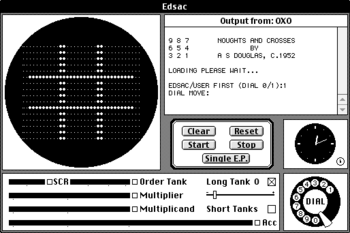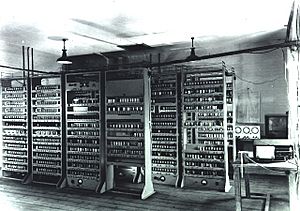OXO (video game) facts for kids
Quick facts for kids OXO |
|
|---|---|

OXO played in an EDSAC simulator for the Classic Mac OS
|
|
| Designer(s) | A S Douglas |
| Platform(s) | EDSAC |
| Release date(s) |
|
| Genre(s) | Puzzle |
| Mode(s) | Single-player |
OXO is a very old video game created in 1952. It was made by A S Douglas and lets you play noughts and crosses (also known as tic-tac-toe). This game is important because it was one of the very first video games ever made! Douglas created OXO as part of his school project at the University of Cambridge. He was studying how people and computers work together.
The game ran on a huge computer called the Electronic Delay Storage Automatic Calculator. EDSAC was one of the first computers that could store programs and remember information. It had special screens, and Douglas used one to show the game board. After Douglas finished his project, the game was not kept on the computer. But much later, people were able to rebuild it!
OXO and another game called draughts (checkers) were some of the first games to show pictures on a screen. Because of this, some people think OXO might be the very first video game. However, some definitions say a game needs moving pictures or real-time updates to be a video game.
How OXO Was Made

The Electronic Delay Storage Automatic Calculator was a giant computer built at the University of Cambridge. It was finished in 1949 and used until 1958. The EDSAC was one of the first computers that could store its own instructions. It was so big it filled an entire room!
This computer had three special screens. These screens showed what the computer was doing. Sandy Douglas, a student at the university, used one of these screens for his project. He wanted to show how computers could display information to people. So, he decided to make a game appear on the screen.
Douglas used the EDSAC to play a game of noughts and crosses. The game board appeared on the screen. Like many early computer programs, OXO was not saved after it served its purpose. Douglas just called it "noughts and crosses." The name OXO was given to it much later by a computer historian.
Around the same time, another game was made by Christopher Strachey. It was a draughts (checkers) game that also showed pictures on a screen. It's not clear which game was shown first. Both OXO and Strachey's game are important because they were the first to use screens to show game visuals.
Playing the Game
When you played OXO, you played against the computer. The computer was very smart and could play a "perfect" game of tic-tac-toe. You would choose your move using a special rotary dial controller, like an old telephone dial. You picked which of the nine squares you wanted to place your mark.
Your move would then appear on the screen. After that, the computer would make its move. The game screen only changed when a new move was made. OXO was not a game you could just play anywhere. It was only available at the University of Cambridge's lab. This was because the EDSAC computer was huge and could not be moved. The game was only for school research, not for fun.

